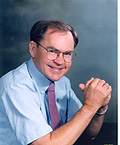Computer Graphics Imagery for Motion Pictures and Commercial Advertising: The Achievement of Highly-Realistic Images
Category
Published on
Abstract
 Recent major advances in the generation of very highly-realistic images in computer graphics, for motion pictures, commercial advertising, or computer games, have been achieved by applying some basic principles from Mechanical Engineering Radiation Heat Transfer. Many of the concepts would be familiar to undergraduates who have taken an introductory course in Heat Transfer. Those concepts are now also well know in Computer Science by workers generating synthetic images, and include the concepts of radiosity, surface light reflection (specular, diffuse, or highly-directional), light-scattering and emission by gases and particulates, subsurface light scattering (human skin, oceans), and the simple, but accurate, visual representation of engineering artifacts (cars, spacecraft, manufactured objects). Some examples would include the ballroom scene in "Beauty and the Beast," the underwater scenes in "Finding Nemo," and the actor simulations (yes, they were synthesized) in the "Matrix" series. The talk will review some of the underlying concepts from Radiation Heat Transfer that have now been implemented in synthetic images. In many cases, researchers in graphics have created algorithms that are many times faster and more detailed than the engineering algorithms from which they were derived.
Recent major advances in the generation of very highly-realistic images in computer graphics, for motion pictures, commercial advertising, or computer games, have been achieved by applying some basic principles from Mechanical Engineering Radiation Heat Transfer. Many of the concepts would be familiar to undergraduates who have taken an introductory course in Heat Transfer. Those concepts are now also well know in Computer Science by workers generating synthetic images, and include the concepts of radiosity, surface light reflection (specular, diffuse, or highly-directional), light-scattering and emission by gases and particulates, subsurface light scattering (human skin, oceans), and the simple, but accurate, visual representation of engineering artifacts (cars, spacecraft, manufactured objects). Some examples would include the ballroom scene in "Beauty and the Beast," the underwater scenes in "Finding Nemo," and the actor simulations (yes, they were synthesized) in the "Matrix" series. The talk will review some of the underlying concepts from Radiation Heat Transfer that have now been implemented in synthetic images. In many cases, researchers in graphics have created algorithms that are many times faster and more detailed than the engineering algorithms from which they were derived. Bio
 After receiving his doctoral degree, Torrance held a joint appointment with the Fire Research Section of the National Bureau of Standards, and the Factory Mutual Engineering Corporation, in Norwood, Massachusetts. He joined the Cornell faculty in 1968. At the university he is associated with the graduate Fields of Mechanical Engineering and Aerospace Engineering and the Program of Computer Graphics. During 1974-75, he held a fellowship in the Advanced Study Program at the National Center for Atmospheric Research in Boulder, Colorado. He is a fellow of the American Society of Mechanical Engineers, a fellow of the American Association for the Advancement of Science, and a member of the American Physical Society and the Association for Computing Machinery (ACM). In 1994 he received the ACM SIGGRAPH Computer Graphics Achievement Award.
After receiving his doctoral degree, Torrance held a joint appointment with the Fire Research Section of the National Bureau of Standards, and the Factory Mutual Engineering Corporation, in Norwood, Massachusetts. He joined the Cornell faculty in 1968. At the university he is associated with the graduate Fields of Mechanical Engineering and Aerospace Engineering and the Program of Computer Graphics. During 1974-75, he held a fellowship in the Advanced Study Program at the National Center for Atmospheric Research in Boulder, Colorado. He is a fellow of the American Society of Mechanical Engineers, a fellow of the American Association for the Advancement of Science, and a member of the American Physical Society and the Association for Computing Machinery (ACM). In 1994 he received the ACM SIGGRAPH Computer Graphics Achievement Award. Sponsored by
Mechanical Engineering Graduate Seminar
Cite this work
Researchers should cite this work as follows:
Time
Location
ME 161, Purdue University, West Lafayette, IN